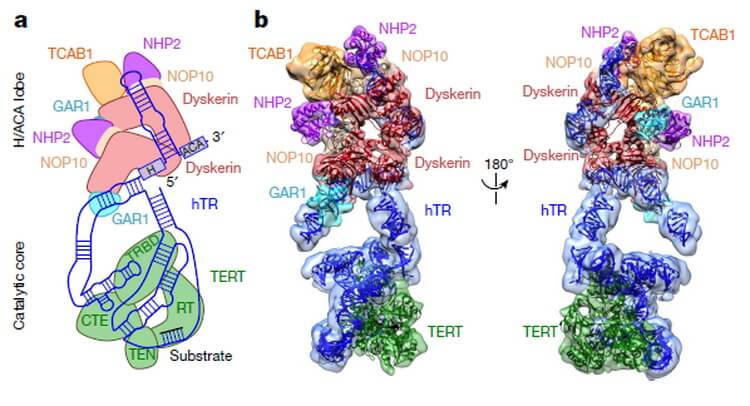- Get link
- X
- Other Apps

Scientists of the Department of Cellular and Molecular Biology of the University of California at Berkeley, using the method of cryoelectron microscopy, obtained the most detailed picture of the structure of human telomerase, an enzyme that provides immortality of cells. The researchers shared the results of the work done and the intricacies of the enzyme structure .
To start the synthesis of a new chain, the mechanism of DNA replication requires the presence of a short matrix, which is then destroyed. During the process, at the end of each chromosome there are unreplicated short pieces that continue to be shortened with each round of replication. Save important parts of the chromosome from the terminal underreplication help telomeres - areas at the ends of the chromosomes, consisting of repeated sequences and representing essentially "reserve" DNA. The telomere length limits the number of cell divisions by a certain value (the Hayflick limit). In cell lines, the length of telomeres is maintained at a constant level by the telomerase enzyme, which preserves the chromosome ends and prevents their wear, which in turn leads to aging of the body cells, writes phys.org.
Since telomerase is also involved in the processes of carcinogenesis (tumor formation), it is of great interest to scientists as a starting point for the development of cancer therapy - substances that suppress its activity can stop the growth of the tumor. However, in order to develop effective enzyme inhibitors, it is necessary to represent its structure in detail. The general outline of the structure of telomerase is fairly well understood. At the moment, the best structure with a resolution of nine angstroms was obtained for telomerase infusoria tetrakhimens. But, of course, the main interest for physicians is the structure of the human enzyme. And just here there is a shortage of sufficiently qualitative data on its structure.
Using cryoelectron microscopy technology, researchers from the University of California at Berkeley under the direction of Kathleen Collins obtained images of human telomerase associated with the substrate at subnanometric resolution of 7.7 and 8.2 angstroms.

Untreated images of telomerase particles

Detailed structure of telomerase
The identified structure still lacks small details, but in combination with knowledge of the sequence of human telomerase genes, it provides enough information to start thinking about potential medicines that will help slow aging and cure cancer.
The article is based on materials .
- Get link
- X
- Other Apps
Comments
Post a Comment